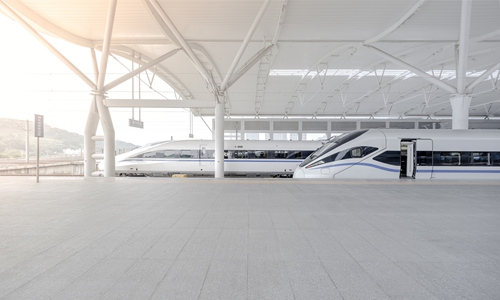HOME >> SOURCE
Talents in the Yangtze Delta anticipate deepened regional integration
By Yu Xi Source:Global Times Published: 2019/12/18 17:08:40
Linking lands along the river

High-speed trains parked at a railway station Photo: cnsphoto
On a Monday around 5:30 am, Alex wakes up, packs his bags, kisses his wife and two children, and takes a 15-minute taxi ride from his home in Wuhu, a small city in East China's Anhui Province, to the town railway station, where he then boards the bullet train to his office in Shanghai, about 350 kilometers from Wuhu.
It's a normal Monday morning for Alex, 36, who works as a salesman at a multinational company specializing in chemical materials for auto parts. About three hours later, Alex arrives at the Shanghai Railway Station.
Alex started this commute in 2016, working in Shanghai during workdays and reuniting with his family during weekends. A good salary kept him going. Thanks to the rapid development of the railway networks in the Yangtze River Delta region, Alex has shortened his commuting time to about four hours from six hours in the past.
"I used to drive to commute, but sometimes it's too tired to drive especially when you just spend a tired working day," Alex told the Global Times. "I like the bullet train, which could let me take a nap."
The Delta in orbit
Alex is not the only commuter who notices the rapid development of the railway networks in the region. Huang Haibo, a researcher specializing in the religious studies from Shanghai Academy of Social Sciences, echoed Alex's opinion.
"Normally, it's very hard to buy a ticket from the neighboring cities to Shanghai on Monday morning 8 am, while it's also hard to buy tickets getting out of the town on Friday afternoon," Huang told the Global Times, evoking the dramatic boom of the weekday and weekend commutes between Shanghai and its neighboring cities such as Hangzhou, capital of East China's Zhejiang Province and Nanjing, capital of East China's Jiangsu Province, in recent years.
Huang is also among the many commuters to Shanghai, living in Suzhou, Jiangsu, and working in downtown Shanghai, about 100 kilometers from Suzhou.
Huang's commute is about half an hour with the bullet train.
"I planned to take advantage of the commuting time during the train, but I found it's too fast. I even didn't start to work, and the train has arrived at Suzhou," Huang laughed.
The Yangtze River Delta region spans Anhui, Jiangsu and Zhejiang provinces and Shanghai, with the most-developed high-speed train networks covering more than 30 major cities in the region.
About 20 high-speed railways have opened in the past decade in the Yangtze River Delta region, such as the lines linking Shanghai and Hangzhou; Hefei, capital of Anhui and Nanjing.
So far this year, passenger journeys made through the Yangtze River Delta railway networks hit 700 million, marking a new historical record, said media reports.
Healthcare and education
Huang knows there is a large group of commuters like him shuttling between two cities. Focusing on religious studies, he often goes on business and research trips to study in different cities. "Relatively, my working time is flexible," Huang said.
Huang's colleague, Luo Cheng, also a religious researcher, shared a similar story. Luo commutes from Shanghai to Nanjing, where her family lives. Luo said she is often on business trips, conducting research in small cities of the region where people like her are used to working in different places.
Both Huang and Luo are quite satisfied with their lifestyles because Suzhou is "less populated" and has a "better natural environment," while Luo's daughter can get a "better education" in Nanjing's primary school.
With a 358,000-square kilometers expanse, as one of the country's most economically invigorating regions, the Yangtze River Delta region has sped up its opening to the world as the Chinese central government has recently released a blueprint for the further region integration.
"I care very much on my daughter's education," Luo told the Global Times, noting that she has done a thorough research over the education resources in both Shanghai and Nanjing.
Luo said she hopes regional integration can "optimize the allocation of education resources." Many talents at her age care more about children's education and elderly healthcare. More talents would like to "work in smaller cities if their offspring could enjoy good education and be looked after well in old age," Luo noted.
Many talents working and living in two different places are facing the problems of helping their senior parents deal with the medical bills in different cities. The interviewees hoped regional integration could speed up improvements in this field.

Commuters hurrying through the aisles Photo: cnsphoto
Hope on the horizon
Chen Shida, a senior researcher from Zhejiang Institution of Talent Development, also expressed his wish for deepened integration in healthcare and education. Chen takes talents working in neighboring cities but living in Shanghai as an example, as those people might have concerns whether they could receive the same treatment as a Shanghainese after retirement.
"Our job is to do thorough research and advice the local governments to make sustained policies to attract more talents," Chen told the Global Times, adding that the municipal governments in the region will certainly compete to establish attractive policies for talents and support development.
"It's a good trend that integration could guide more talents into smaller cities, which are underdeveloped and full of opportunities," Chen noted.
The blueprint released by the central government on December 1 encourages talents go back to their hometown to start their own businesses. This is music to Alex's ears.
"Working in Shanghai alone makes you lonely," Alex said. "I hope I could spend more time with my family."
Posted in: INDUSTRIES,ECONOMY